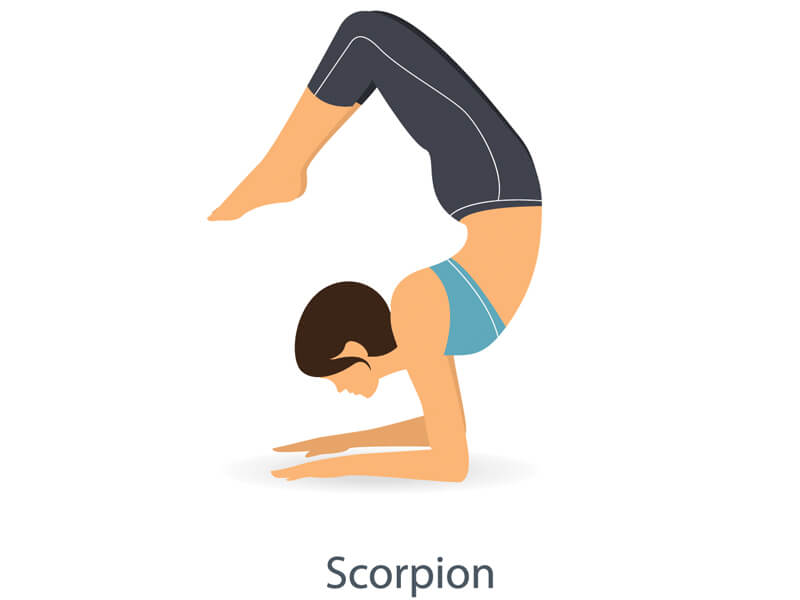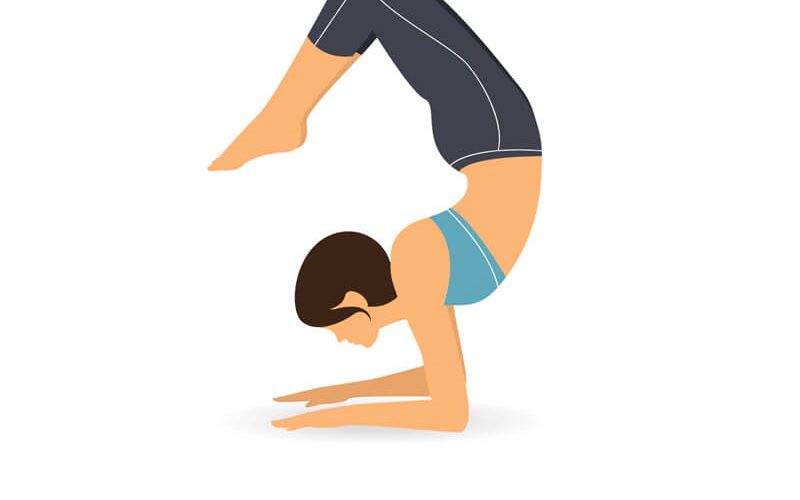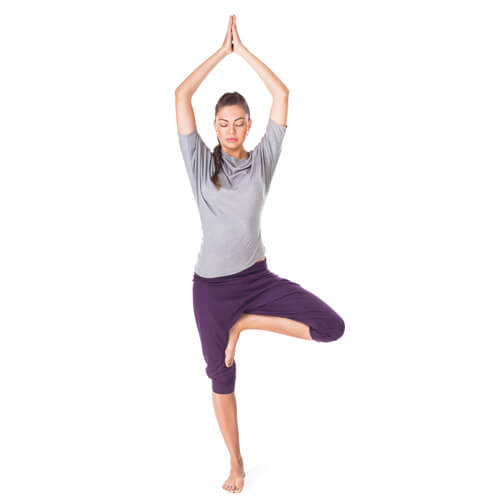The Vrischikasana, or Scorpion Pose, is a beautiful, difficult yoga posture that requires balance, strength, and flexibility. This pose makes you look like a scorpion about to strike and is an advanced pose that will help build a deeper connection between your mind and body as you take your yoga practice to the next level.
What is Vrischikasana?
Vrischikasana, also known as the Scorpion Pose, is a difficult yoga pose. It looks like a scorpion with its tail up. The person doing this pose will have their legs lifted above them while balancing on their forearms. The body follows a curved shape, with the feet close to the head. This pose is important in yoga as the scorpion symbolizes the power to change negative energy into something positive.

Image Source: Shutterstock
The scorpion yoga pose is seen as a way to turn negative energy into something positive. It is also believed to activate the kundalini energy stored in the spine. Doing this pose requires strength, balance, and flexibility, showing that the yogi has control over their body and mind.
Vrischikasana may be difficult, however, it provides physical advantages such as increased strength and suppleness, while also acting as a strong means of self-exploration and spiritual progress.
Benefits of Vrischikasana
Vrischikasana offers many advantages for both your body and mind, such as:
- Vrischikasana helps you build strength in your core muscles, including your abs. To do this pose properly, you need a strong and stable core in order to remain balanced and lift your legs.
- Doing the scorpion pose can help make your body more steady.
- This exercise stretches the chest, shoulders, and spine while strengthening the hip flexors, making them more stable.
- Doing Vrischikasana can make your arms, shoulders, and upper body stronger.
- This pose boosts blood flow to the brain, helping to sharpen mental focus by activating the nervous system when inverted.
- Vrischikasana helps you take deep breaths and be mindful, which can help to reduce your stress and worries.
- This pose helps you stay focused and mindful since it needs lots of focus.
- Doing the Vrischikasana can help you feel more confident, fight a fever, and help you feel more relaxed.
How to Practice Vrischikasana
Here are the simple steps that help you practice Vrischikasana or the Scorpion pose efficiently.
- Begin by doing a handstand with your arms. Put your hands on the floor with your elbows shoulder-width apart and join your fingers together. This will create a solid foundation for your head.
- Lay on the mat with the top of your head between your arms and look slightly ahead.
- Move your feet closer to your head and lift your hips to make a “V” shape.
- Gently raise your leg up towards your head while keeping the other leg on the ground for balance.
- Strengthen your midsection muscles so that you can stay steady. If you feel comfortable, try lifting your second leg.
- Strengthen your middle and keep steady by using your core muscles. If you feel secure, you can slowly raise your other leg off the floor.
- Try to make your legs straight and lift them up toward the sky if you feel comfortable.
- As you do Vrischikasana, your body makes a graceful curve with your feet pointing towards your head.
- Stay in this position for as long as you can and pay attention to your slow and steady breathing.
- Lower your legs to the floor, one at a time, until you are back in the forearm stand position.
- At last, relax in a pose like a child or any other position that is comfortable when you finish the Forearm stand.
Preparing for Vrischikasana
The Vrischikasana, or Scorpion Pose, is an advanced yoga posture that requires a lot of strength, balance, and flexibility. If you are just starting to do yoga, be careful when attempting this pose. To make sure you do not get hurt, it is best to get help from an experienced yoga instructor. Here are some tips to help you get ready to do the Vrischikasana.
- Start with a good warm-up routine, concentrating on your spine, shoulders, and wrists.
- Begin by doing the Downward-facing dog and Dolphin poses to get your body ready for the Scorpion pose.
Safety and Precautions
Vrischikasana, or the Scorpion pose, is a difficult move that takes time to master. So, it is important to practice it safely and be aware of your body and alignment before attempting it. Here are some safety tips to remember before doing the pose.
- If you are just starting out, it’s a good idea to use a wall for stability to prevent getting hurt.
- If you have hurt your neck or shoulders, don’t do this pose. Make sure you’re flexible and strong enough before trying it.
- Remember to move forward slowly and don’t rush anyone into a position.
- If you are feeling overwhelmed, you can ask a professional for help.
- Pregnant women should not do this pose during the early stages of pregnancy.
Variations of Vrischikasana
The Scorpion pose has different versions for people of different skill levels. All the variations help with strength, flexibility, and balance, and can be adjusted to suit different people’s abilities. Some of the common variations of the pose are:
Forearm Stand (PinchaMayurasana)
This pose, also known as Forearm Stand, is a beginner version of Vrischikasana. The person does the pose by balancing on their arms while lifting their legs up straight.
One-Legged Scorpion (Eka Pada Vrischikasana)
This variation is a good stepping stone to the full pose, which involves lifting one leg overhead while the other remains vertical.
Straddle Scorpion (Vrischikasana with Straddle)
In Scorpion Pose, the practitioner will have you stretch your legs out far apart, making the pose more difficult.
Bent-Knee Scorpion
This pose is called “bent knees” because you don’t need to straighten your legs completely. This makes it easier for some people to do.
Wall-Assisted Scorpion
Doing the Scorpion Pose against a wall can help you stay balanced and stop you from feeling scared of falling, which is useful for people just starting out.
Headstand Scorpion (Shirshasana Vrischikasana)
This variation of poses requires great strength in your core and upper body. It involves putting your legs over your head while in the Headstand, also known as the Shirshasana and the Scorpion Pose.
Vrischikasana in Lotus (Padmasana Vrischikasana)
This pose is perfect for experienced yogis because it involves going into Scorpion Pose while in the Lotus Pose, with your legs crossed over each other.
Handstand Scorpion
This type of move requires a lot of strength and control; it involves doing the Scorpion Pose while upside down in a Handstand.
Note: Only do these Vrischikasana poses if you are strong, flexible, and know how to do the basic forearm stand. It’s best to get help from a yoga teacher to avoid any accidents.
The Scorpion pose (Vrischikasana) is a difficult, advanced yoga pose that requires a lot of strength and balance. It can be a very rewarding experience, as it pushes you to reach your highest potential. It is important to make sure that you are comfortable with all the other poses before attempting the Scorpion pose. Let us know if this article was helpful to you!
FAQs:
1. Should beginners practice Vrischikasana?
Beginners attempting Vrischikasana, an advanced yoga pose, can be risky. It is advised to master basic inversions and seek guidance before fully practicing the Scorpion pose at home.
2. What common mistakes should be avoided while practicing Vrischikasana?
Some of the common mistakes one should avoid while practicing the Scorpion pose include
- Avoid over-arching the lower back.
- Support the weight by using the neck.
- Don’t collapse the shoulders.
3. What are the things to keep in mind to practice The Scorpion pose?
- You can use your forearms for support.
- Prioritize proper alignment.
- Avoid rushing into the pose.
- Focus on engaging the core.
- Maintain a straight line from head to heels.
Read More:



